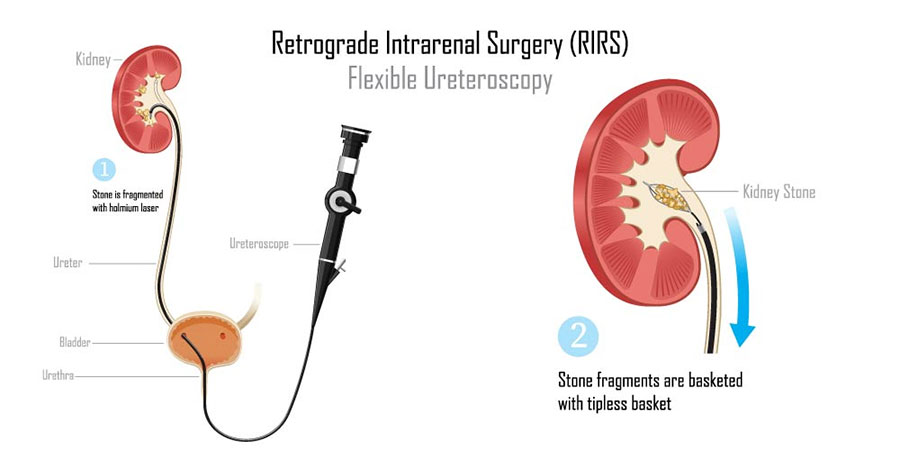

Urinary tract procedures such as RGP (Retrograde Pyelogram), DJ Stenting (Double J Stent Placement), and Stent Removal are commonly performed to diagnose, manage, and prevent urinary tract obstructions. These procedures are often used in cases involving kidney stones, ureteric strictures, or after urological surgeries to ensure proper urine drainage from the kidneys to the bladder. Each procedure plays a vital role in maintaining healthy kidney function and preventing complications such as hydronephrosis or infection.
RGP (Retrograde Pyelogram)
Retrograde Pyelogram (RGP) is a minimally invasive diagnostic procedure used to visualize the ureters and renal pelvis using contrast dye and fluoroscopy. It helps detect blockages, strictures, or anatomical abnormalities that may not be fully visible on standard imaging techniques like ultrasound or CT scans.
Indications
- Evaluation of ureteral obstruction or strictures.
- Detection of ureteric stones, tumors, or congenital anomalies.
- Investigation of persistent hematuria or unexplained flank pain.
Procedure
- Preoperative Preparation: Patient evaluation, urinalysis, and antibiotic prophylaxis.
- Cystoscopy and Catheterization: A cystoscope is inserted through the urethra to visualize the bladder.
- Fluoroscopy or X-ray images capture the dye’s movement, identifying blockages or abnormalities.
DJ Stenting (Double J Stent Placement)
DJ Stenting (Double J Stent Placement) involves inserting a flexible ureteral stent with curled ends (J-shape) at both ends to facilitate uninterrupted urine flow from the kidneys to the bladder. The stent prevents or relieves ureteral obstruction and maintains proper drainage.
Indications
- Relief of ureteric obstruction due to stones, strictures, or tumors.
- Postoperative placement following ureteroscopy (URS), PCNL (Percutaneous Nephrolithotomy), or ureteric surgery.
- Management of hydronephrosis due to malignancy or obstruction.
Procedure
- Preoperative Evaluation: Patient counseling, imaging, and antibiotic prophylaxis.
- Insertion of Cystoscope: A cystoscope is introduced through the urethra into the bladder.
- Stent Placement: A guidewire is passed through the ureteric orifice into the kidney.
Stent Removal
Stent Removal is a simple, minimally invasive procedure performed to remove a DJ stent after its intended purpose is fulfilled. It is generally performed under local anesthesia using a cystoscope.
Indications
- Completion of post-operative healing after stone removal or ureteric surgery.
- Resolution of ureteral obstruction or strictures.
- Routine removal after temporary placement to prevent encrustation and infection.
Procedure
- Preparation: Antibiotics may be given prophylactically to prevent infections.
- Cystoscopy and Visualization: A cystoscope is inserted through the urethra to visualize the bladder.
- Stent Extraction: Grasping forceps or a stent removal device is used to gently extract the stent.
Benefits of RGP, DJ Stenting, and Stent Removal
- Accurate Diagnosis with RGP: Provides a detailed evaluation of ureteric and renal anatomy.
- Relief of Ureteral Obstruction with DJ Stenting: Protects the ureter and promotes healing after surgical procedures.
- Safe and Quick Stent Removal: Reduces the risk of stent-related complications such as infection or encrustation.
Postoperative Care and Follow-Up
- Antibiotics and Pain Management
- Hydration and Urine Monitoring
- Regular Follow-Up: Cystoscopy may be recommended to assess ureteral healing and monitor for recurrence.
RGP, DJ Stenting, and Stent Removal are essential procedures in the diagnosis, treatment, and management of ureteral obstructions and urinary tract abnormalities. RGP aids in identifying blockages, DJ Stenting maintains urinary flow and promotes healing after surgery, and Stent Removal ensures the safe extraction of stents once their purpose is served. Together, these procedures ensure optimal kidney function and prevent complications, offering a safe and effective solution for patients with complex urological conditions.